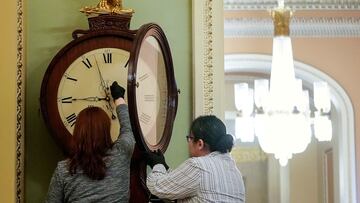Are we gaining or losing an hour with the start of Daylight Saving Time?
Twice a year, most Americans have to move their clocks either forward or backward. So are we gaining or losing an hour with Daylight Saving Time?

Whether you are a fan or not of Daylight Saving Time, clocks will spring forward yet again in 2024 on Sunday 10 March at 2 am. Perhaps the federal legislation that proposes to end the twice-yearly practice will gain more traction this year.
But in the meantime, Americans in most US states will have to set their clocks forward one hour, if they don’t do so automatically. This means for those people that they will be losing an hour of sleep as 8 am will be 7 am, for example.
The time change, which takes place twice a year, forward in spring and then backward in autumn, in principal is done to take advantage of the longer days in the summer months to save energy. However, for those who are caught unaware of the ritual they may find themselves showing up for an appointment at the incorrect time. Thus the shift is always done on the weekend to limit the amount of disruption caused.
Efforts to make daylight saving time permanent
There has been a legislative push to do away with changing the hour on the clock altogether by Congress and state governments. Nineteen states have introduced legislation to do away with the twice-yearly switch. However, currently states are forbidden from switching to permanent daylight saving time under federal law. The authority to do so has been reserved by the Department of Transportation since 1966.
In Congress, there is a proposal, known as the Sunshine Protection Act, that would establish permanent daylight saving time nationwide. Senator Marco Rubio has reintroduced the bill yet again in 2024 ahead of the beginning of Daylight Saving Time. The legislation gained momentum in 2022 passing the Senate but the House never took a vote on it. Last year, it was reintroduced but failed to even get out of committees in either the House or Senate.
Part of the problem is that no one can agree on whether we should get rid of the twice-yearly time change, nor if we were to do so, which time should we stick to, permanent standard time or daylight saving time.
There are competing views on its effectiveness at saving energy as well as the effect it has on people’s health. Not to mention which, standard or saving time, is better for our circadian rhythm.
Residents in some states will not be changing their clocks
The only parts of the US that do not have DST are sections of Arizona, Hawaii, Puerto Rico, the US Virgin Islands, Northern Mariana Islands, Guam, and American Samoa.
Arizona experimented with the change beginning in 1918 but decided to opt out of the Daylight Savings Time in 1968 permanently. Although the state observes Standard Time, the Navajo Nation, a Native American territory in the northeast of the state, which also crosses over into New Mexico and Utah, does make the twice-a-year time shift.
Thanks to their position near the equator, Hawaii, Puerto Rico and US territories in the Pacific. Since they are close enough to the equator that there is no significant difference in sunrise and sunset times across the year, there are no benefits from changing the hour.






